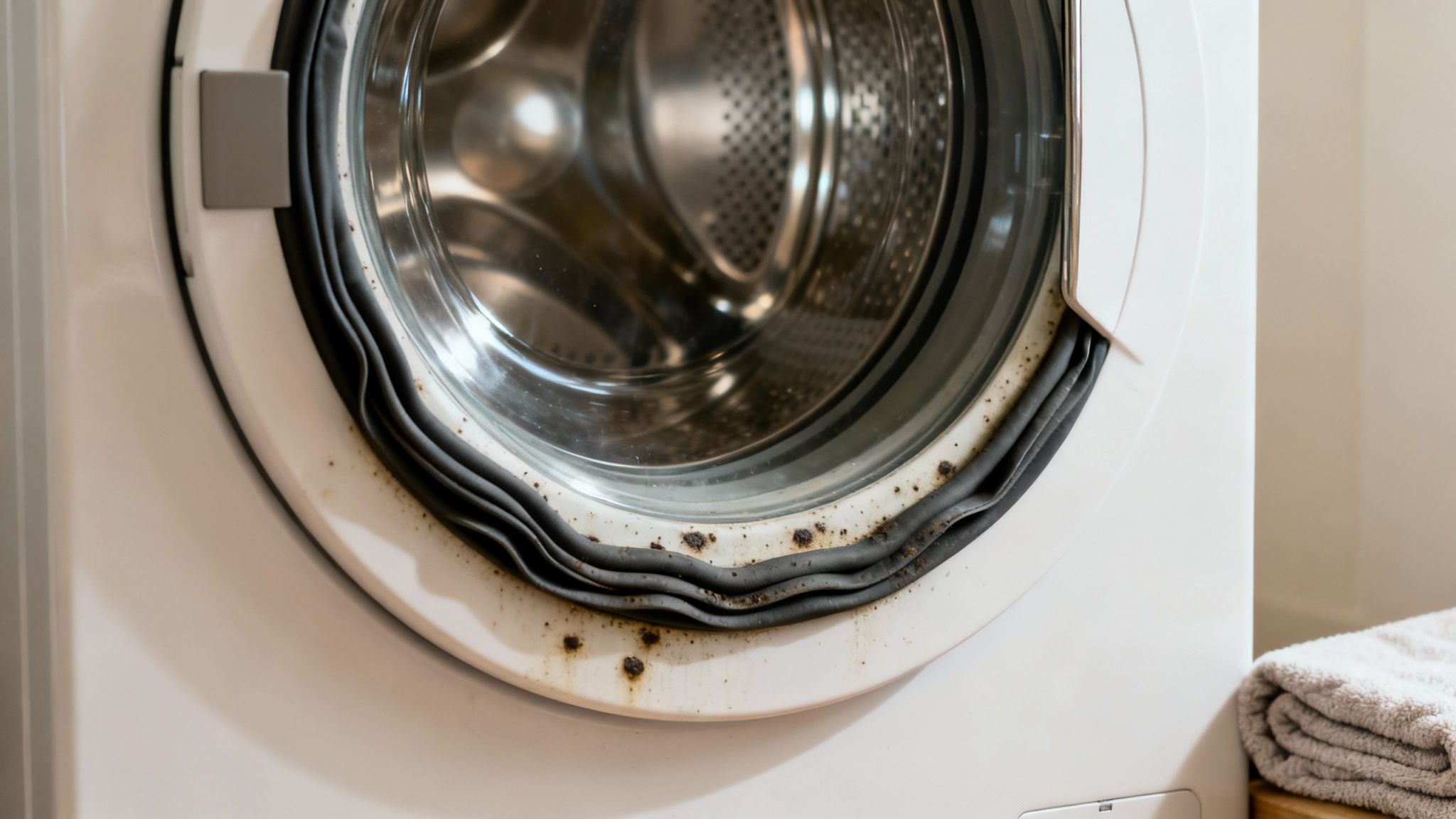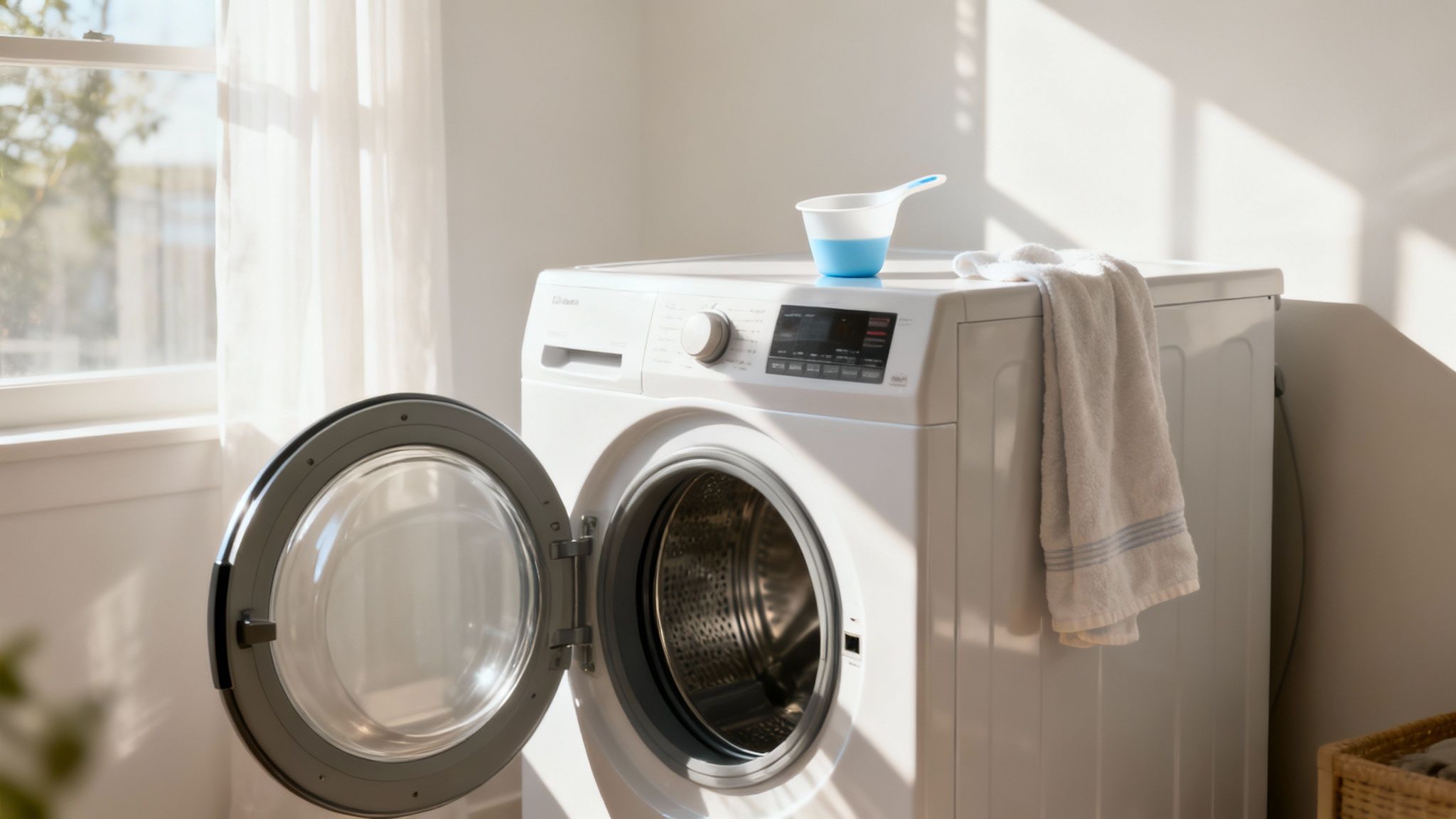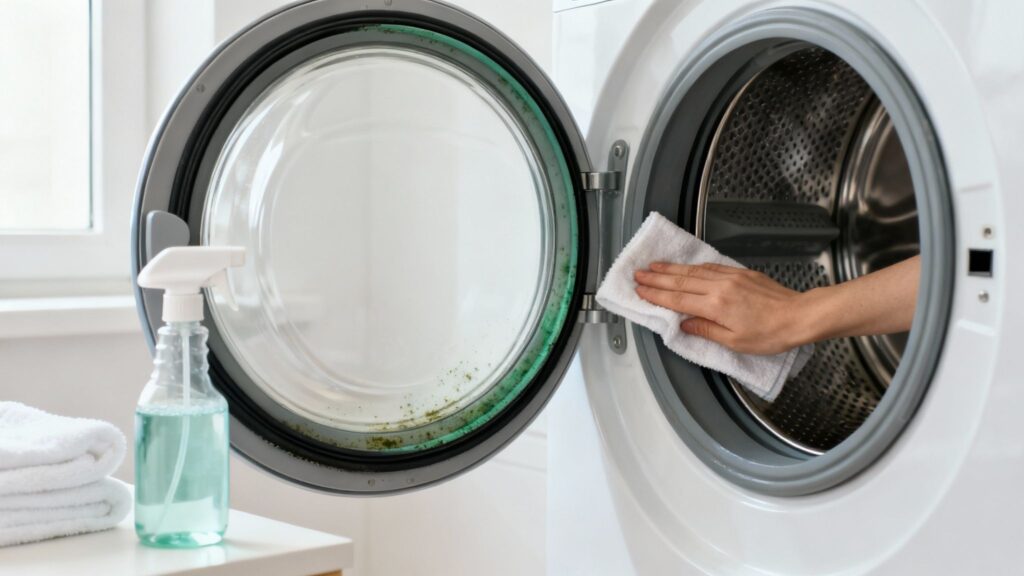That musty smell wafting from your front-load washer isn't just unpleasant—it's a tell-tale sign that moisture, leftover soap, and lint have created the perfect party for mildew. The main issue is the machine's airtight design, which is great for efficiency but notorious for trapping water in the rubber door seal and drum. This is a common complaint we hear from homeowners across North Dallas, from Plano to Celina.
For a quick fix, run an empty cycle on the hottest setting with a dedicated washer cleaner or a bleach solution. This is a great first step to sanitize the machine and start knocking out the odor.

Why Your Front Load Washer Smells Like Mildew in Plano
If you're a homeowner in Plano or McKinney battling that stubborn washer smell, you’re definitely not alone. Front-load washing machines are water-saving champs, but that efficiency comes at a cost: they are mildew magnets.
Unlike old-school top-loaders, their horizontal drums and tight rubber door seals create a dark, damp playground where mold and bacteria thrive. Every time you shut that door after a load, you're trapping moisture inside. Before long, that trapped humidity turns into a funky, musty odor that can even start to affect your "clean" laundry, a frequent issue for families in Allen.
The Most Common Culprits Behind the Odor in North Dallas Homes
Getting to the bottom of the smell is the only way to get rid of it for good. For most households in Frisco and Allen, the problem usually boils down to a few common habits.
- Too Much Detergent: It feels counterintuitive, but using more soap than you need—especially non-High-Efficiency (HE) detergent in an HE machine—leaves behind a sticky residue. This gunk is basically a buffet for mold.
- Fabric Softener Buildup: Liquid fabric softeners are known for creating a waxy film inside the drum and on the gasket. This film not only traps moisture but also attracts grime and lint.
- Moisture in the Gasket: That rubber seal around the door is ground zero for mildew. Water pools in its folds, and if it isn't wiped dry, it becomes a breeding ground for smelly bacteria.
- Letting Wet Clothes Sit: We've all done it, but leaving a finished load in the washer, even for just an hour or two, creates a steam room effect that kicks mold growth into high gear.
Even if you're not in the middle of a deep clean, there are things you can do right now to combat that smell. The table below links the most common causes to simple, immediate actions you can take today.
Immediate Fixes for Front Load Washer Odors
| Common Cause | Immediate Solution | What to Avoid |
|---|---|---|
| Trapped Moisture in Gasket | After the last load, wipe the rubber door seal dry with a microfiber cloth. Leave the door ajar. | Snapping the door shut right after unloading. This seals in all the moisture. |
| Detergent Residue | Run a hot, empty "tub clean" cycle. Add 1 cup of white vinegar to the detergent drawer to help break down soap scum. | Using more detergent than the manufacturer recommends, thinking it will clean better. |
| Stagnant Water in Drum | If possible, manually drain the machine using the small drain hose, usually located behind a small panel on the front. | Letting the washer sit unused for weeks with the door closed. |
| Lingering Humidity | Point a small fan at the open washer door for 30-60 minutes after your last load to speed up the drying process. | Ignoring the smell. It will only get worse and can transfer to your clothes. |
The key takeaway? It's not a flaw in the machine itself, but a matter of maintenance. The very features that make your washer efficient—like that airtight seal—also require you to adjust your laundry routine to keep things dry and fresh.
The good news is that these problems are completely fixable. With a few small tweaks, you can prevent that musty smell from coming back and get back to having laundry that actually smells clean. You can even discover more about front load washer maintenance to keep your machine in top shape.
The Hidden Health Concerns of Washer Mildew for Allen Families
Let's be honest, that musty smell coming from your front-loader isn't just an annoyance. It’s a pretty clear signal that something is growing in there, and for families across North Dallas, it’s worth paying attention to. The dark, damp world inside your washer's rubber gasket and drum is the perfect breeding ground for all sorts of unseen microbes.
That sour, "off" smell? It's caused by something called microbial volatile organic compounds, or MVOCs. These are basically tiny gas byproducts released by mold and bacteria as they eat and multiply. So when you crack open that washer door, you're not just getting a whiff of old water—you're breathing in these compounds.
What's Really Growing in There?
It’s a bit unsettling to think about, but your machine’s warm, humid interior can become a home for a whole colony of unwelcome guests. Studies have found common molds like Aspergillus and even the notorious Stachybotrys chartarum (black mold) setting up shop in washing machines. They're often joined by bacteria you really don't want on your clothes, like E. coli and Pseudomonas aeruginosa, which thrive in the leftover water and soap scum.
"The biofilm that develops inside the washer's gasket and drum is a complex ecosystem. It’s a mixture of detergent residue, fabric softener, lint, and moisture that actively feeds mold and bacteria, allowing them to thrive."
The real kicker is that these microorganisms don't just stay put. They can easily transfer to your laundry during a wash cycle, meaning your "clean" clothes might be anything but. For homeowners in Plano and Frisco, this realization often turns that unpleasant odor into a genuine health concern that needs to be tackled head-on.
How Washer Mildew Can Affect Your Family
This isn't just a cleaning issue; it's an indoor air quality issue that can impact your family's health, especially if anyone is sensitive.
Here’s what you could be dealing with:
- Allergic Reactions: Mold spores are classic allergens. Think sneezing, itchy eyes, a runny nose, and even skin rashes that seem to come out of nowhere.
- Respiratory Problems: Breathing in those MVOCs and spores can irritate the lungs and throat. For anyone with asthma, this can make their symptoms much worse.
- Skin Irritation: When your clothes are washed in a contaminated machine, they can carry mold fragments and bacteria right to your skin. This can lead to irritation or dermatitis, particularly for people with sensitive skin.
Experts have cataloged dozens of mold and bacteria types that just love these damp environments. Their growth doesn't just stink up your laundry room; it poses real health risks. To get a better sense of what's at stake, you can discover more about the hidden dangers of washer biofilm and see the full picture. It’s exactly why keeping that machine clean is about more than just fresh-smelling clothes—it’s about your family’s well-being.
Your Deep Cleaning Guide to Banish Washer Odors in McKinney
Running the built-in "clean cycle" is a fine maintenance step, but if your front-load washer already smells like a damp basement, it’s time to roll up your sleeves. A true deep clean goes beyond just the drum; it’s a hands-on mission to get rid of the gunk and biofilm that are feeding that awful smell. This is how we get machines in homes from Celina to Plano smelling brand new again.
Forget a quick surface wipe. We're going after the three main culprits: the rubber door gasket, the detergent dispenser, and the drum itself. When you tackle these spots head-on, you eliminate the source of the odor instead of just trying to cover it up.
Tackling the Rubber Gasket
That rubber door seal is ground zero for mildew. Its design, with all those flexible folds, is practically an invitation for water, lint, and soap scum to get trapped and fester.
To really clean it, you have to get inside those folds. Start by mixing equal parts white vinegar and water in a spray bottle. Drench the entire gasket, then gently pull back the seal from the drum. Don't be surprised if you find a nasty layer of black or gray slime—that's the biofilm causing the smell. Grab a microfiber cloth or an old toothbrush and scrub it all away.
Cleaning the Detergent Dispenser
Next up is the detergent dispenser drawer. It’s so easy to overlook, but that sticky film from leftover soap and fabric softener is a magnet for mold.
Most dispenser drawers are designed to be removed. Check your owner's manual, but there's usually a small tab or button you press to release it. Once it's out, let it soak in a sink full of warm, soapy water for about 30 minutes. Use a small bottle brush to get into every little compartment and crevice. While the drawer is soaking, take a cloth and wipe down the inside of the dispenser housing—it’s another sneaky spot where grime builds up.
This infographic shows just how easily a small issue like mildew can escalate, impacting your home's overall air quality.

As you can see, those mildew spores don't just stay in the washer. They release compounds that get into the air you breathe, which is exactly why this deep clean is so crucial.
Running a Sanitizing Cycle
With the gasket and dispenser sparkling, the last step is to sanitize the drum and all the internal parts you can't see. You have a couple of great, effective options here.
-
The Vinegar & Baking Soda Method: Sprinkle 1/2 cup of baking soda right into the empty washer drum. The baking soda acts as a gentle abrasive to scrub the interior and absorbs lingering odors. Then, pour 2 cups of white vinegar into the detergent dispenser and run the machine on its longest, hottest cycle (look for settings like "Sanitize" or "Tub Clean").
-
The Commercial Cleaner Method: If you prefer a dedicated product, grab a washing machine cleaner like Affresh tablets. It couldn't be simpler—just pop one tablet into the empty drum and run the hottest cycle.
A thorough monthly deep clean is one of the best investments you can make in your appliance's longevity and your home's air quality. It prevents the slow accumulation of biofilm that becomes a much bigger problem later.
Once the cycle is complete, give the inside of the drum a quick wipe-down and, most importantly, leave the door propped wide open for a few hours to let everything air out completely. Making this a regular habit is the secret to keeping that mildew smell from ever returning to your North Dallas home.
For a deeper dive, feel free to check out our complete guide on cleaning smelly washing machines for even more pro tips.
Simple Habits to Keep Mildew From Coming Back
You've put in the work to get your machine sparkling clean, so the last thing you want is that musty, mildew smell sneaking back into your laundry room. The good news? Keeping it fresh is far easier than deep cleaning it. It really just boils down to a few simple habits that stop mildew before it ever gets a foothold.
The biggest culprit, especially with front-loaders, is moisture trapped by that airtight door. Your main goal is to introduce airflow. Making these small adjustments will make a massive difference, something homeowners from Plano to Frisco can appreciate.

Adopt These Non-Negotiable Laundry Habits
Think of these as the new rules of your laundry room. Once you work them into your routine, they become second nature and are hands-down the best way to maintain a fresh-smelling washer.
- Leave the Door Ajar: This is the golden rule. After your last load of the day, always leave the washer door cracked open. It’s the easiest way to let the drum and gasket dry out completely, starving mold of the damp environment it needs to grow.
- Wipe Down the Gasket: After you’re done with laundry, grab a dry cloth and give the rubber door seal a quick wipe. It only takes 30 seconds to get rid of any pooled water in the folds and stop that slimy biofilm from forming.
- Remove Wet Clothes Promptly: We’ve all done it—forgotten a load in the washer. But letting wet clothes sit creates a warm, humid incubator for mildew. Set a timer on your phone so you remember to move everything to the dryer right away.
Fine-Tuning Your Detergent Use
Believe it or not, your detergent—and how much you use—plays a huge part in preventing odors. Soap residue that doesn't rinse away is a primary food source for mold, so getting your detergent routine right is crucial.
First off, always use a detergent made for High-Efficiency (HE) machines. HE detergents are designed to be low-sudsing for the low water levels in front-loaders. If you use a standard detergent or even just too much HE soap, you’ll get excess suds that leave behind a sticky film—the perfect fuel for mildew. This is a common problem we run into in homes all over McKinney and Allen.
I can't stress this enough: you probably need way less detergent than you think. For a normal load, two tablespoons is often plenty. Over-pouring is one of the fastest ways to create the residue that leads to bad smells.
To help you choose the right products for routine maintenance, here’s a quick breakdown of the most common options.
Comparing Washer Cleaning Agents
This table compares a few popular choices for your monthly cleaning cycle, looking at how well they work and any safety notes to keep in mind.
| Cleaning Agent | Effectiveness on Mildew | Safety Considerations | Recommended Frequency |
|---|---|---|---|
| White Vinegar | Good for breaking down soap scum and killing mild mildew. | Safe for most machines. NEVER mix with bleach, as it creates toxic gas. | Once a month |
| Chlorine Bleach | Excellent for killing mold, mildew, and bacteria. | Check your owner’s manual first. Can be harsh on rubber seals over time. | Every 1-2 months |
| Commercial Cleaners | Formulated to dissolve residue and kill microbes effectively. | Generally very safe. Follow the package directions precisely. | Once a month |
| Baking Soda | Helps absorb odors and gently scrubs the drum. | Completely safe. Often used in combination with vinegar. | As needed |
Choosing the right cleaner for your machine and schedule is a key part of the process.
By turning these tips into habits, you're doing more than just cleaning your washer; you're creating an environment where mildew simply can't survive. For more expert advice, feel free to browse our other articles covering professional washer odor removal strategies.
When a Deep Clean Is Not Enough in Your Celina Home
You’ve done everything right. You scrubbed the gasket until it was spotless and ran a cleaning cycle with vinegar and baking soda. But within a day or two, that familiar musty smell is already creeping back.
It’s an incredibly frustrating experience, and it’s a sure sign that the problem is more than just surface-level grime. If a deep clean doesn't fix it, it’s time to stop scrubbing and start looking for a deeper issue. A smell that keeps coming back is one of the most reliable clues that a hidden mechanical problem is brewing inside your washer.
Identifying Deeper Mechanical Issues
When that front-load washer smell just won't quit, it's often because the source is in a part of the machine you can't see or easily reach. These are the red flags telling you that you’re dealing with more than a simple cleaning task.
- The Smell Returns Immediately: If the odor is back right after a thorough cleaning, the mildew source is likely somewhere the cleaning cycle can't touch, like deep within the drain system.
- Visible Mold in Hidden Spots: You might catch a glimpse of mold inside the drain hose or near the pump housing. These areas are usually inaccessible without taking things apart.
- Water Left in the Drum: After a cycle finishes, is there a small pool of water still sitting at the bottom of the drum? That’s a classic sign of a drainage problem that’s leaving stagnant, smelly water behind every single time you do laundry.
A very common culprit behind these issues is a clogged drain pump filter. This little part is designed to catch lint, forgotten coins, and other small debris. Once it’s blocked, your washer can’t drain all the water out, creating the perfect swampy environment for mildew to thrive.
The Risk of Ignoring the Signs
It can be tempting to just keep using the washer and hope the smell goes away, but that can lead to much bigger problems. A struggling drain pump or a failing seal won't fix itself. In fact, the constant strain can burn out the motor or cause a leak that ends up damaging your floor.
This is where you really need a professional diagnosis. An experienced technician can safely get into the machine, inspect the drain pump, check for blockages, and figure out if any seals are failing. Understanding the potential costs to fix a washing machine can help put things in perspective—a small repair now is always cheaper than replacing a major part or dealing with water damage down the line.
Common Questions About Washer Odors in North Dallas
Even after a deep clean, it’s normal to still have some questions. We get calls all the time from homeowners across the Plano and Allen area wondering why their front-load washer still smells like mildew. Let's tackle some of the most common ones we hear.
How Often Should I Deep Clean My Front-Load Washer?
For most families around Frisco and McKinney, getting in there for a deep clean about once a month is a solid routine. This is more than just hitting the "clean cycle" button—I'm talking about actually scrubbing the gasket and pulling out the dispenser drawer to get rid of all that gunk.
Now, if you've got a big family, are constantly washing muddy sports uniforms, or just dealing with our lovely Texas humidity, you might need to step it up. In those cases, even something as simple as wiping the door seal dry after you finish the last load can make a world of difference.
Is It Safe to Use Chlorine Bleach to Clean My Washer?
Absolutely, and it's fantastic for killing off mold and mildew. But first, do a quick check of your owner's manual. Most machines are fine with it, but a few specific models might advise against it.
If you're good to go, just pour about 1/2 cup of bleach directly into the bleach dispenser and run the hottest cycle your machine has, completely empty.
A crucial word of caution here: Never, ever mix bleach with other cleaning agents, especially vinegar or anything containing ammonia. This is a recipe for creating toxic chlorine gas, which is incredibly dangerous. Stick to one cleaner at a time.
The Mildew Smell Came Right Back! What Did I Miss?
Ah, the classic mystery. If that musty smell returns almost immediately, it's a dead giveaway that you missed a hidden spot where biofilm is still hanging out. Nine times out of ten, it's one of two places:
- The Dispenser Housing: The cavity behind the dispenser drawer you pull out. It's a prime spot for sludge to build up.
- The Drain Pump Filter: This little trap, usually hidden behind a small door at the bottom front of your washer, is designed to catch lint, hair, and whatever else falls out of pockets. It can turn into a smelly swamp if forgotten.
Check your manual for how to safely clean out that filter. If you've tackled both of these spots and the odor lingers, you could be looking at a more serious drainage problem that needs a technician to properly diagnose.
Why Do I Really Need to Leave My Washer Door Open?
This is probably the single most important habit you can adopt to prevent mildew. That smell is from mold, and mold loves one thing: moisture. Leaving the door open allows air to circulate, which lets the drum and that rubber gasket dry out completely.
It’s a simple trick that starves the mold of the damp environment it needs to thrive. If you have curious pets or small kids and worry about safety, look into a magnetic door prop. They keep the door cracked open just enough for airflow without leaving it wide open.
If you feel like you've tried everything and are still losing the battle against the funk, it's time to call in a pro. For fast, reliable appliance repair in Plano, Allen, or anywhere in North Dallas, trust ThumbUp.Pro. Our certified technicians can find the real source of the problem and get your machine smelling fresh again. Book online at https://thumbup.pro and save $20 on your service call.

